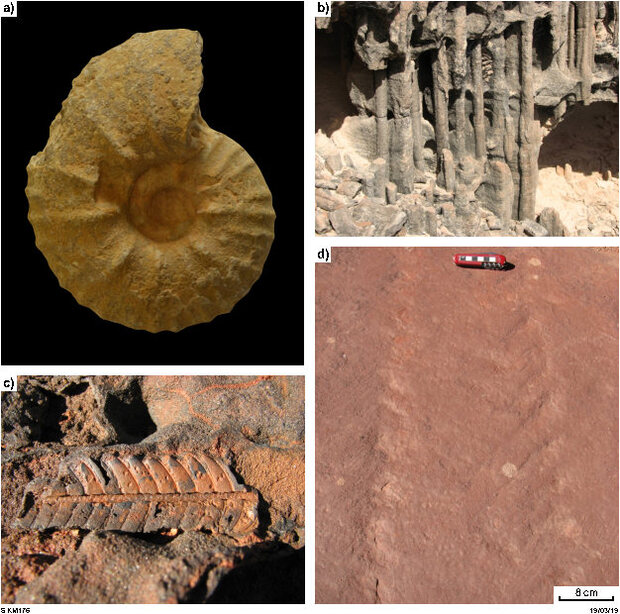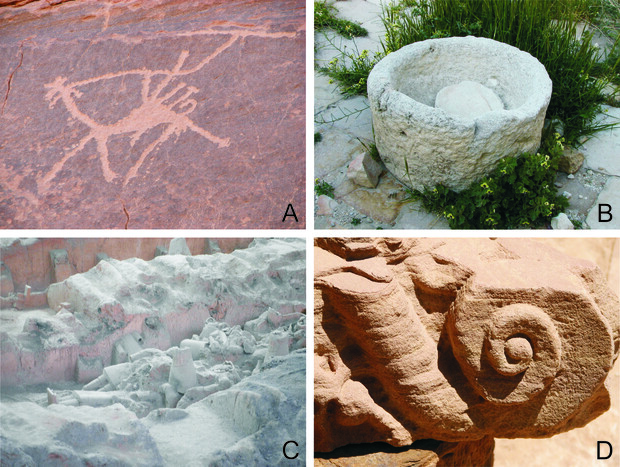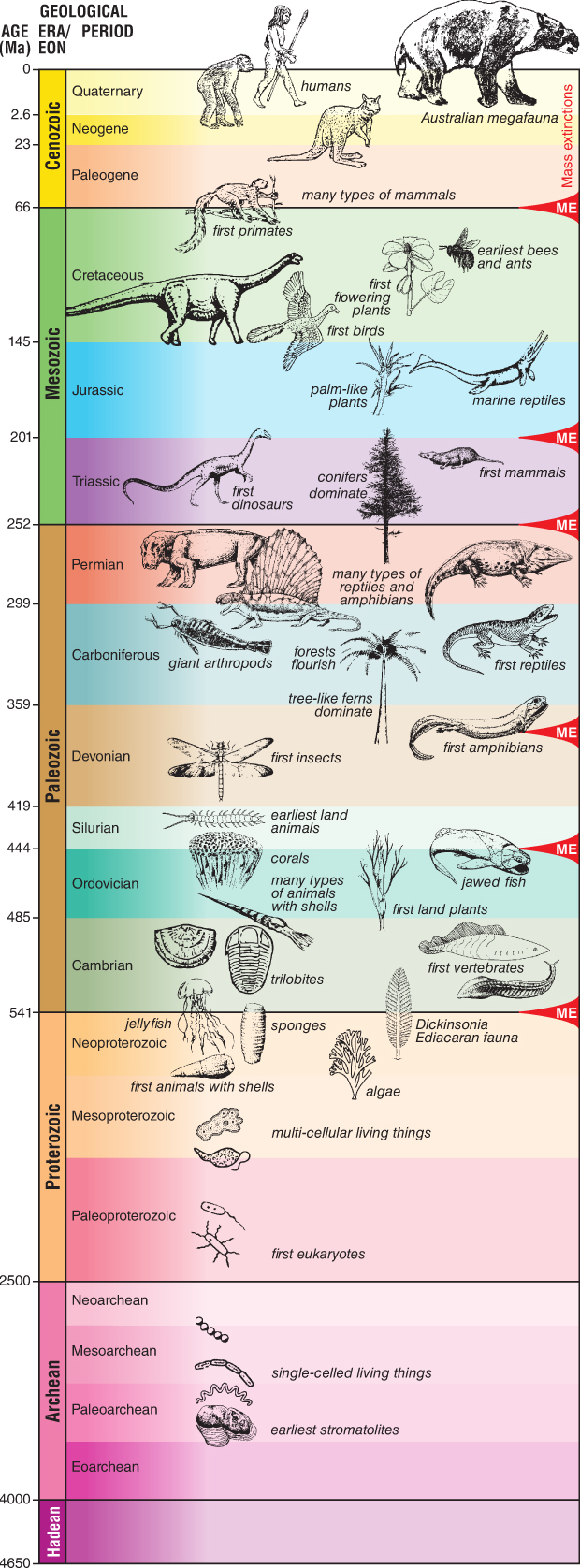Fossils are the geologically altered remains of a once-living organism and/or its behaviour. There are two main types: body fossils represent all or part of the organism’s body, and trace fossils show evidence of the organism’s behaviour. The study of fossils is called paleontology, from the Greek meaning ‘ancient (paleo-) being (onto-) study (-logy)’. Scientists who study fossils are called paleontologists. Fossils are of particular interest to geologists as they can help determine the age of a particular rock compared to other rocks, or identify the environment in which the rock was formed.
What can become a fossil?

Any living thing — animal, plant, bacterium or fungus — has the potential to become a fossil, but because the process of fossilisation is destructive not everything that dies is preserved. Most dead organisms are eaten, rot away or are destroyed by the environment before they have the chance to become fossils.
Some animal or plant parts preserve more readily than others. For example, bones fossilise better than flesh and organs, because fewer predators and scavengers eat bones, and they are more resistant to physical and chemical destruction. Organisms like jellyfish with no hard parts like bones or shells are rare in the fossil record because they are less likely to be preserved.
Normally, only the toughest parts of the toughest animals and plants become fossils. But occasionally the environment is just right to preserve complete soft-bodied organisms that are rarely fossilised, or an entire ecosystem. These special locations are commonly called lagerstätten, a German word meaning ‘storage place’. These sites are important to scientists as they can tell us a lot about how the animals lived and died, and how the different types of organisms interacted with one another and the environment. Special environmental conditions are generally required to form one of these sites — either the animals were quickly killed and buried through anaerobia (lack of oxygen) or volcanic ash, or the water chemistry was particularly good at preserving the bodies.
Western Australia’s Gogo Formation in the west Kimberley is considered a lagerstätten by scientists as a number of beautifully preserved fish (some including evidence of live birth) have been found — including Western Australia’s State fossil.
Body fossils, like the ammonite (A) and plant fossil (B), seen in the image above, are the remains of the organism’s ‘body’, whereas trace fossils, like the worm burrows (C) and arthropod trackways (D), preserve evidence of an organism’s behaviour, such as eating, walking or living.
How can behaviour be preserved?
Sometimes, organisms leave behind indications of their behaviour such as tracks or burrows, without leaving behind parts of their bodies. These fossilised behaviours are known as trace fossils. Trace fossils can include animal footprints, bite marks, coprolites (fossil dung), or a preserved nest or burrow. They might tell us about how an organism moved, where and how it lived, what it ate, and how it hunted and socialised.
It is often hard to tell what organism made a trace, unless a body fossil is found close by, and sometimes trace makers can be deduced by comparing them to modern organisms. Even if the culprits cannot be found, trace fossils still reveal much about how organisms lived and their environment. For example, tracks preserving fine details suggest they were made on a damp but exposed surface, whereas tracks with a washed out look may be formed underwater, or were washed out almost immediately.
What isn’t a fossil?

Very recent remains that haven’t been buried or have only been buried very shallowly, or have not been altered by long periods of time, are not considered fossils. This would include shells on the beach or a skeleton of a recently dead animal. But, scientists have different opinions about how long remains need to buried and how altered they must be to qualify as fossils. Deciding whether remains are fossils or not can be a tricky business.
All scientists agree that items made by humans, such as buildings, paintings, books, pottery and coins, are not fossils. These artefacts are studied by archaeologists, not paleontologists.
Occasionally, rocks can contain minerals or features that look like fossils, but in fact are not biogenic (made by living organisms). These features are known as pseudofossils.
How do scientists determine what is a fossil and what isn’t?
The oldest potential fossils are often incredibly difficult to confirm as biological in origin, as they often do not preserve any trace of original biological material, are simple in form, and can be vastly different from any known organisms seen on the planet today. As a result, this issue of biogenicity is of primary concern for scientists working in Archean and Proterozoic rocks, but can also be a problem for poorly known or poorly preserved Phanerozoic fossils.
Traditionally, the criteria applied to determine whether a feature is a fossil include morphology (especially comparison to living organisms), preserved structure and texture, structural organisation and consistency (both within a single individual and between individuals of the same type), and biochemistry (if available). For problematic fossils, scientists expand this to seven main criteria:
- structures should be in rocks of known provenance (similar structures restricted to a similar area and time frame)
- structures should be indigenous to the rocks, not on top of the surface etc.
- structures should be formed at the same time as the sediment
- structures should have formed in an environment suitable for life
- structures should be of assured biological origin; i.e. preserving chemical indicators of biological tissue
- structures should show evidence of taphonomy; i.e. differences in preservation caused by decay, or fossilisation under different environmental conditions
- structures should show biofabric evidence; i.e. variations in the types of tissue throughout the organisms.
It is not a requirement that all of these factors be strictly met for a structure to be considered a fossil, although all should be argued in a rational manner. As an example, criteria five is particularly difficult to prove, even in relatively recent fossils, as it requires an unusual fossilisation environment and only minor alteration of the rocks after formation.
How are fossils formed?
There are four main steps to making a fossil (see image below):
- First, an organism dies. Anaerobic conditions exclude bacteria and other predators that consume bodies before burial, so organisms that die in the deepest ocean or in a deep lake are more likely to become fossils.
- Next, the remains need to be buried in soft sediment. Rapid burial increases the chances of fossilisation because a body is less likely to be consumed or destroyed by the environment such as wind, waves and scavengers.
- This is followed by a period of burial, which can range from a few thousand years up to millions of years. During this time, the rocks around the body will change the shape, and the chemical and mineral composition, of the buried body parts. This alteration can be relatively subtle, such as mummification or some types of recrystallisation, or can be very obvious in the case of impression (casts) or compression fossils. Fossils are preserved best when the environment they are buried in is not affected by later erosion, volcanism, heating, compression or stretching, or strong chemical alteration.
- Finally, the rocks around the fossil need to be eroded, allowing them to become exposed to the Earth's surface in time for a paleontologist to come past and find it.

How do fossils help geologists?

The fossil record shows us that different periods of geological time had very different animals and plants. The life found in every environment changes constantly through time, with species appearing, becoming extinct, evolving, or moving to other environments.
Distinctive fossils (or groups of fossils, called assemblages) can tell geologists how old a rock is in relation to other rocks in the area. Fossil assemblages also help geologists match the age of rocks in one area to another area, or even worldwide if the organism lived in a wide range of places. This use of fossils to help understand the age of rocks is called biostratigraphy.
Fossils including trace fossils are used by sedimentologists to determine environmental aspects, like climate, altitude, aquatic, terrestrial, water depths and acidity, in which the organisms lived, died, and were buried. This aspect of fossil analysis is known as paleoenvironmental studies.
Further Reading
- Benton, MJ and Harper, DAT 2009, Introduction to paleobiology and the fossil record: Wiley-Blackwell, Chichester, UK, 608p
- Fortey, R 2009, Fossils: the key to the past: Natural History Museum, London, UK, 256p.
- Prothero, DR 2007 Evolution: what the fossils say and why it matters: Columbia University Press, New York, USA, 408p
- Vickers Rich, P, Rich, TH, Fenton, MA and Fenton, CL 1996, The fossil book: a record of prehistoric life, 2nd edition: Dover Publications, Mineola, New York, USA, 776p.
Western Australian fossil law
In Western Australia, fossicking and fossil collecting is permitted under the following conditions:
- collectors first obtain a Miner’s Right from the Department of Mines, Industry Regulation and Safety (DMIRS)
- written permission has been granted when collecting on people’s property or pastoral leases
- no collecting is to be made on Crown Reserves (e.g. National Parks, State Forest areas, regulated Geoheritage Reserves) without prior written approval from the relevant State or Federal Government agencies. The only exceptions to this are those State Reserves listed as having a Common, Public Utility or Mining purpose.
All collectors are encouraged to bring interesting fossils to either GSWA or the Western Australian Museum for identification. Understanding what fossils are found and where helps scientists better understand the geology of the State and helps government correctly identify and regulate important fossil sites for future generations.
It should be remembered that any Australian fossils sent overseas (even for non-commercial purposes) are subject to Federal Heritage laws. See the Federal Moveable cultural heritage website for more information.
Many of the fossils discussed here, including the Trendall locality ‘egg carton’ stromatolites, can be seen in the Western Australian Museum’s Origins gallery.
External links covering a range of topics relating to Australian fossils, paleontology and geological time can be found on External websites.
More information on fossils and paleontology data within GSWA
More information on Western Australian fossils can be found in the Western Australian Museum.
Contact
For more information contact:
paleontology@dmirs.wa.gov.au
